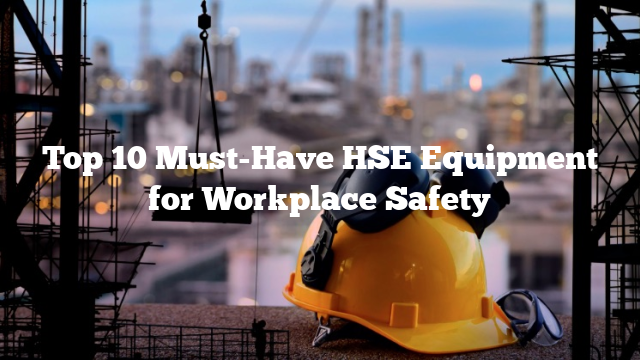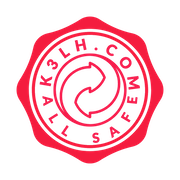Introduction:
Health, safety, and environment (HSE) is an essential aspect of any workplace. It’s the responsibility of every organization to prioritize the safety of its employees, clients, and the environment. One of the ways to achieve this is by having a comprehensive HSE equipment list. This list includes all the necessary equipment and tools required to ensure the safety of workers and the environment. In this blog post, we’ll explore the importance of an HSE equipment list, what it should include, and some tips for creating one that’s effective and efficient.
What is an HSE Equipment List?
An HSE equipment list is a comprehensive inventory of all the equipment and tools required to ensure the safety of workers and the environment. It lists all the necessary equipment and tools that should be available in the workplace to minimize the risk of accidents, injuries, and environmental damage. An HSE equipment list is an essential component of any organization’s safety management system.
Why is an HSE Equipment List Important?
An HSE equipment list is crucial for the following reasons:
1. Compliance with regulations: Every organization is required to comply with various HSE regulations. An HSE equipment list helps to ensure that all necessary equipment is available to comply with these regulations.
2. Minimizing risk: Workplace accidents and environmental damage can be costly for organizations. An HSE equipment list helps to minimize the risks of accidents, injuries, and environmental damage.
3. Ensuring worker safety: An HSE equipment list ensures that workers have access to all the necessary equipment and tools to keep them safe while on the job.
4. Improving productivity: When workers feel safe, they are more productive. An HSE equipment list helps to create a safer work environment, which can lead to increased productivity.
Facts about HSE Equipment List:
1. An HSE equipment list should be regularly reviewed and updated to ensure it remains relevant and effective.
2. The equipment and tools on the HSE equipment list should be properly maintained and serviced to ensure they function correctly when needed.
3. An HSE equipment list should be easily accessible to all workers.
4. An HSE equipment list should be created with input from all stakeholders, including workers, managers, and HSE professionals.
Listicle: What Should an HSE Equipment List Include?
An HSE equipment list should include:
1. Personal Protective Equipment (PPE): This includes safety helmets, gloves, safety glasses, and respirators.
2. First Aid Kits: A first aid kit should be available in every workplace. It should include bandages, antiseptics, and other essential items.
3. Fire Extinguishers: Fire extinguishers should be easily accessible and properly maintained.
4. Safety Signs: Safety signs should be posted in visible locations to warn workers of potential hazards.
5. Environmental Equipment: This includes spill kits, waste containers, and other equipment to ensure environmental safety.
6. Emergency Equipment: This includes emergency lighting, alarms, and communication equipment.
Tutorial: How to Create an Effective HSE Equipment List
Creating an effective HSE equipment list involves the following steps:
1. Review HSE regulations: Review the HSE regulations that apply to your organization to determine the necessary equipment and tools.
2. Consult with stakeholders: Consult with workers, managers, and HSE professionals to ensure that all necessary equipment is included.
3. Organize the list: Organize the list according to categories such as PPE, first aid, fire safety, and environmental equipment.
4. Prioritize equipment: Prioritize the equipment according to its importance in ensuring worker safety and environmental protection.
5. Ensure availability: Ensure that all equipment is readily available and easily accessible to workers.
Tips: How to Maintain an Effective HSE Equipment List
1. Regularly review and update the list to ensure it remains relevant and effective.
2. Conduct regular inspections of the equipment to ensure that it’s in good working condition.
3. Train workers on the proper use and maintenance of the equipment.
4. Ensure that all equipment is properly stored and labeled.
Question and Answer of HSE Equipment List:
1. What are the consequences of not having an HSE equipment list?
Answer: Not having an HSE equipment list can lead to workplace accidents, injuries, and environmental damage, which can be costly for organizations.
2. Who is responsible for maintaining an HSE equipment list?
Answer: It’s the responsibility of every organization to prioritize the safety of its employees, clients, and the environment. Therefore, every organization should maintain an HSE equipment list.
3. How often should an HSE equipment list be reviewed?
Answer: An HSE equipment list should be regularly reviewed and updated to ensure it remains relevant and effective.
4. What should be done if equipment on the HSE equipment list is not functioning correctly?
Answer: Equipment that’s not functioning correctly should be immediately replaced or repaired to ensure that it’s readily available and functional when needed.
Conclusion of HSE Equipment List:
In conclusion, an HSE equipment list is an essential component of any organization’s safety management system. It ensures compliance with regulations, minimizes risk, and ensures worker safety and productivity. An effective HSE equipment list should include personal protective equipment, first aid kits, fire extinguishers, safety signs, environmental equipment, and emergency equipment. It should be reviewed and updated regularly, and all equipment should be properly maintained and accessible. By following the tips outlined in this blog post, organizations can create and maintain an HSE equipment list that’s effective and efficient.
Recommendations:
- Safety Topics Slips Trips And Falls Slips trips and falls is the number 1 reason for an industrial injury in the united states. Preventing slips trips falls safety talk meeting outline follow up on any outstanding…
- Health And Safety Committee Logo Dumpster health and safety signs hard hat truck driver protect your health health safety environment health and safety committee vehicle. Health in each workplace. Call For Joint Health And Safety…
- Workplace Safety Signs And Symbols, Why so important? Proper workplace safety signs and symbols always place in a construction site, mining site, oil and gas site or hospital and your workplace.
- Workplace Safety Inspection Checklist Template Use our professionally designed workplace safety inspection checklist template that you can download instantly. After you have used it a couple of times you may wish to modify it so…
- Workplace Safety Slogans Safety First Quotes See more ideas about safety slogans workplace safety and safety. 167 catchy and funny safety slogans for workplaces 2020 find the best catchy safety slogans for your workplace stop press.…
- Safety Quotes For The Workplace Display them around your workplace or add them to internal newsletters. Apr 25 2019 explore sotorioss board safety quotes for workplace on pinterest. Safety Quotes For The Workplace Safety In…
- Health And Safety Topics Occupational health safety is the industry leading news magazine enewsletter and website for occupational health and safety professionals focusing on problem solving solutions latest news. Health safety committee member health…
- Safety Poster While we are talking about safety poster, most of us need to be a lot more familiar with the safety element of our lives.
- Safety Quotes Pictures A group of wonderfully cared for confident individuals will generate great ideas. You are looking for the safety quotes which helps us to free from harm or danger. Safety Doesn…
- Safety Slogans For September Using a new iphone app a team of social psychology experts has analysed every meaningless aphorism and every condescending platitude ever displayed in the workplace to come up with a…
- Workplace Health And Safety Posters Hand washing posters useful hand washing posters with catchy messages to give a friendly reminder to your employees. Its the law poster available for free from osha informs workers of…
- Workplace Safety Safety Topics Holding employee meetings to discuss relevant workplace safety topics is an important aspect of providing workers with a safe and healthy work environment. Find thousands of safety management resources by…
- Health And Safety Inspection Form Safety inspections are essential to ensuring and effective safety program. More about download the free osh answers app. Workplace Health And Safety Inspection Forms Survey Templates And Alternatively they may…
- Health And Safety Poster Pdf Makrosafe holdings pty ltd is a fully fledged health and safety service provider. Improve health and safety. Mhs Help Files 02 Explain how risks will be controlled in a way…
- Free Health And Safety Images If you're searching for free health and safety images images information linked to the free health and safety images keyword, you have pay a visit to the ideal site. Our…
- Safety Inspection Checklist Template It covers the owner and vehicle details including the complete name of the vehicle owner home address email club membership if there is model chassis no engine no make year…
- Workplace Safety Inspection Checklist Includes checks for fire prevention general safety vehicles. Date item condition follow up needed. Pshsa Sample Workplace Inspection Checklist The best checklist for your workplace is one that has been…
- Inspirational Safety Quotes For Workplace Relevant quotes are a great way to communicate key safety concepts. The use of silly and meaningless safety language matters it creates a distraction and delusion that safety and risk…
- Health And Safety Topics For Meetings Choosing the right eye protection. Staying within the limits of an extended. Coping With Stress At Home Bheema Office Safety Safety Posters The following article lists some relevant safety topics…
- Health And Safety Funny Images If you're searching for health and safety funny images images information related to the health and safety funny images interest, you have pay a visit to the right site. Our…
- Safety Signs Workplace Images Add to likebox 32561215 safety first sign. Find images of safety signs. Workplace Safety Signs Only show results related to. Safety signs workplace images. 38010021 work safety helmet and sign…
- Safety Meeting Topics Fresh ideas for tailgate meetings or safety moments at work. Safety toolbox talks was started in 2007 as a portal for safety professionals to share and exchange free safety topic…
- Safety Slogan Posters Images Following are the safety slogans and taglines. What others are saying industrial safety training servicescourses in india. Foam Sheet Safety Slogan Poster Rs 280 8 Piece Protector Safety slogans be…
- Safety Logo Icon 9652 best safety free vector art downloads from the vecteezy community. All icons are available in svg eps png psd format and as icon font. Worker Hat Safety Icon Royalty…
- Safety Inspection Report For Construction Site Once corrected record corrective action and date next to item. Yes no na date corrected. 22 Sample Construction Report Templates Word Docs Pages Free Be fitted with suitable safety hoops…
- Site Safety Inspection Template Construction site inspection checklist templates are provided here for your convenience. It can be completed in a single inspection or over a series of shorter inspections. Construction Safety Inspection Checklist…
- Safety Glasses Signs Free sign pdfs too. Portrait safety glasses safety shoes and hearing sign nhep 36359 osha notice safety glasses and safety shoes required sign. Safety Glasses Must Be Worn Sign G2610…
- Food Safety Inspection Checklist Template Food safety checklists templates. You can access our templates below. Vehicle Safety Inspection Checklist Form Car Maintenance Tips Food safety checklists form the basis for a food safety system and…
- Workplace Health And Safety Logo The orange color also is representative of the cautious and careful attitude necessary to. Find health and safety logo stock images in hd and millions of other royalty free stock…
- Occupational Safety Logo Looking for free vectors of health and safety. The institution of occupational safety and health iosh is a british organisation for health and safety professionals. Occupational Safety And Health Logo…
Advertisement
Scroll to Continue With Content




